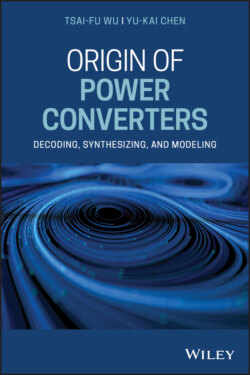Читать книгу Origin of Power Converters - Tsai-Fu Wu - Страница 2
Table of Contents
Оглавление1 Cover
2 Preface
5 Part I: Decoding and Synthesizing 1 Introduction 1.1 Power Processing Systems 1.2 Non‐PWM Converters Versus PWM Converters 1.3 Well‐Known PWM Converters 1.4 Approaches to Converter Development 1.5 Evolution 1.6 About the Text Further Reading 2 Discovery of Original Converter 2.1 Creation of Original Converter 2.2 Fundamental PWM Converters 2.3 Duality Further Reading 3 Fundamentals 3.1 DC Voltage and Current Offsetting 3.2 Capacitor and Inductor Splitting 3.3 DC‐Voltage Blocking and Pulsating‐Voltage Filtering 3.4 Magnetic Coupling 3.5 DC Transformer 3.6 Switch Grafting 3.7 Diode Grafting 3.8 Layer Scheme Further Reading 4 Decoding Process 4.1 Transfer Ratios (Codes) 4.2 Transfer Code Configurations 4.3 Decoding Approaches 4.4 Decoding of Transfer Codes with Multivariables 4.5 Decoding with Component‐Interconnected Expression Further Reading 5 Synthesizing Process with Graft Scheme 5.1 Cell Approaches 5.2 Converter Grafting Scheme 5.3 Illustration of Grafting Converters Further Reading 6 Synthesizing Process with Layer Scheme 6.1 Converter Layering Scheme 6.2 Illustration of Layering Converters 6.3 Discussion Further Reading 7 Converter Derivation with the Fundamentals 7.1 Derivation of Buck Converter 7.2 Derivation of z‐Source Converters 7.3 Derivation of Converters with Switched Inductor or Switched Capacitor 7.4 Syntheses of Desired Transfer Codes Further Reading 8 Synthesis of Multistage and Multilevel Converters 8.1 Review of the Original Converter and Its Variations of Transfer Code 8.2 Syntheses of Single‐Phase Converters 8.3 Syntheses of Three‐Phase Converters 8.4 Syntheses of Multilevel Converters 8.5 L–C Networks Further Reading 9 Synthesis of Soft‐Switching PWM Converters 9.1 Soft‐Switching Cells 9.2 Synthesis of Soft‐Switching PWM Converters with Graft Scheme 9.3 Synthesis of Soft‐Switching PWM Converters with Layer Scheme 9.4 Discussion Further Reading 10 Determination of Switch‐Voltage Stresses 10.1 Switch‐Voltage Stress of the Original Converter 10.2 Switch‐Voltage Stresses of the Fundamental Converters 10.3 Switch‐Voltage Stresses of Non‐Fundamental Converters Further Reading 11 Discussion and Conclusion 11.1 Will Identical Transfer Code Yield the Same Converter Topology? 11.2 Topological Duality Versus Circuital Duality 11.3 Graft and Layer Schemes for Synthesizing New Fundamental Converters 11.4 Analogy of Power Converters to DNA 11.5 Conclusions Further Reading
6 Part II: Modeling and Application 12 Modeling of PWM DC/DC Converters 12.1 Generic Modeling of the Original Converter 12.2 Series‐Shunt and Shunt‐Series Pairs 12.3 Two‐Port Network 12.4 Small‐Signal Modeling of the Converters Based on Layer Scheme 12.5 Quasi‐Resonant Converters Further Reading 13 Modeling of PWM DC/DC Converters Using the Graft Scheme 13.1 Cascade Family 13.2 Small‐Signal Models of Buck‐Boost and Ćuk Converters Operated in CCM 13.3 Small‐Signal Models of Zeta and Sepic Operated in CCM Further Reading 14 Modeling of Isolated Single‐Stage Converters with High Power Factor and Fast Regulation 14.1 Generation of Single‐Stage Converters with High Power Factor and Fast Regulation 14.2 Small‐Signal Models of General Converter Forms Operated in CCM/DCM 14.3 An Illustration Example Further Reading 15 Analysis and Design of an Isolated Single‐Stage Converter Achieving Power Factor Correction and Fast Regulation 15.1 Derivation of the Single‐Stage Converter 15.2 Analysis of the Isolated Single‐Stage Converter Operated in DCM + DCM 15.3 Design of a Peak Current Mode Controller for the ISSC 15.4 Practical Consideration and Design Procedure 15.5 Hardware Measurements 15.6 Design of an H∞ Robust Controller for the ISSC Further Reading
7 Index
